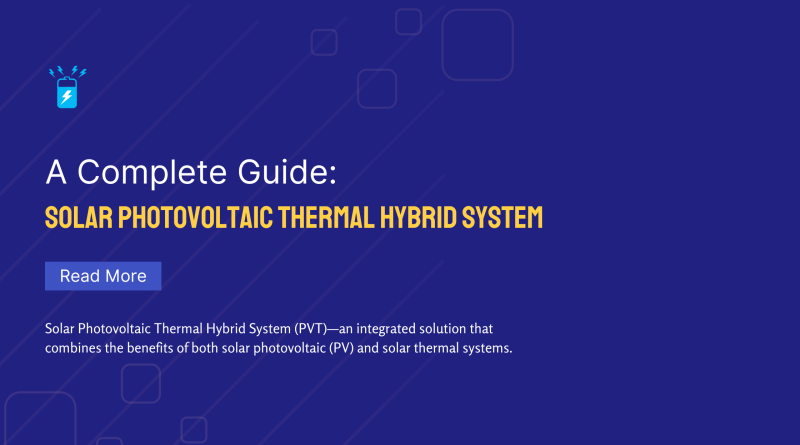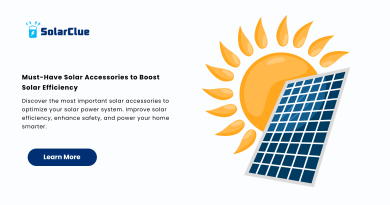Solar Photovoltaic Thermal Hybrid System: A Complete Guide
As the world shifts towards renewable energy, innovative technologies are emerging to maximize the efficiency and effectiveness of solar power. One such advancement is the Solar Photovoltaic Thermal Hybrid System (PVT)—an integrated solution that combines the benefits of both solar photovoltaic (PV) and solar thermal systems. In this blog, we’ll break down what a Solar Photovoltaic Thermal Hybrid System is, how it works, and why it’s an exciting development for anyone interested in harnessing solar energy.
Table of Contents
What is a Solar Photovoltaic Thermal Hybrid System?
A Solar Photovoltaic Thermal Hybrid System (PVT) is an advanced technology that simultaneously generates electricity and heat from the same solar panel. Traditional solar panels convert sunlight into electricity, but they often become hot, which reduces their efficiency. The PVT system captures this heat and puts it to use, making the solar panels more efficient overall.
This dual-function system offers a more comprehensive approach to utilizing solar energy by addressing both electrical and thermal energy needs in a single, integrated solution.
How Does the Solar Photovoltaic Thermal Hybrid System Work?
The Solar Photovoltaic Thermal Hybrid System works by combining photovoltaic cells, which convert sunlight into electricity, with a thermal collector that captures the heat generated by the solar panel. Here’s how it all comes together:
1. Photovoltaic Component:
The PV cells in the hybrid system work like any standard solar panel, converting sunlight directly into electricity. This electricity can be used to power homes, businesses, or other facilities, reducing reliance on grid power.
2. Thermal Component:
Beneath or alongside the PV cells, a thermal collector absorbs the heat produced during the solar energy conversion process. This heat can then be used for various applications, such as heating water, space heating, or industrial processes.
3. Cooling Effect:
The thermal component not only captures useful heat but also helps to cool the PV cells, improving their efficiency. Cooler PV cells can operate more effectively, generating more electricity over time.
Benefits of a Solar Photovoltaic Thermal Hybrid System
The Solar Photovoltaic Thermal Hybrid System offers several advantages that make it an attractive option for those looking to maximize their solar energy investment:
Increased Efficiency:
By capturing and using the heat that would otherwise be wasted, PVT systems can increase the overall efficiency of solar panels. This means you get more energy output—both electrical and thermal—from the same surface area.
Space-Saving:
Since the system combines two functions into one, it requires less space than installing separate photovoltaic and thermal systems. This is especially beneficial for buildings with limited roof space.
Cost-Effective:
Over time, the dual production of electricity and heat can lead to significant savings on energy bills. The PVT system can also reduce the need for additional heating systems, lowering installation and operational costs.
Environmental Impact:
By making the most out of the available sunlight, PVT systems help reduce the overall carbon footprint. They enable a more efficient use of renewable resources, contributing to a greener environment.
Applications of Solar Photovoltaic Thermal Hybrid Systems
The versatility of Solar Photovoltaic Thermal Hybrid Systems makes them suitable for a wide range of applications, including:
Residential Use: Homeowners can use PVT systems to generate electricity while also heating water for domestic use, reducing energy bills and dependence on fossil fuels.
Commercial Buildings: Businesses can benefit from the dual energy output to power operations and provide heating or cooling, making commercial spaces more energy-efficient.
Industrial Processes: In industrial settings, where both electricity and heat are often required, PVT systems can be used to meet both needs efficiently, reducing energy costs and improving sustainability.
Future of Solar Photovoltaic Thermal Hybrid Systems
As solar technology continues to evolve, Solar Photovoltaic Thermal Hybrid Systems are expected to become more popular. Advances in materials and design will likely lead to even higher efficiency rates and lower costs, making this technology accessible to a broader audience. Additionally, the integration of PVT systems with other renewable energy technologies, such as wind or geothermal, could further enhance their effectiveness and appeal.
Ready to Harness the Full Potential of Solar Energy?
If you’re interested in getting the most out of your solar investment, consider exploring a Solar Photovoltaic Thermal Hybrid System. Whether you’re a homeowner, a business owner, or part of an industrial operation, PVT systems offer a versatile and efficient solution for your energy needs.
Engage with Us! Have questions or want to learn more about how a PVT system could work for you?
Leave a comment below or get in touch with us today for a personalized consultation.
Let’s work together to maximize the power of the sun!




